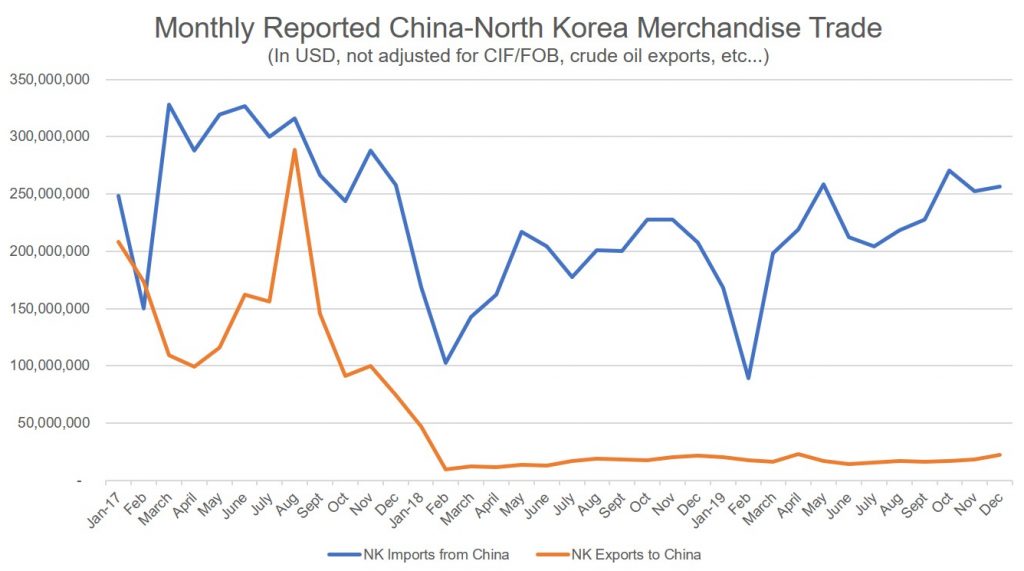China-North Korea Trade: Parsing the Data
Since the imposition of far-reaching United Nations sanctions on North Korea in 2016-2017, China has accounted for 95 percent of the world’s reported merchandise trade with North Korea, according to mirror statistics published by the DPRK’s trading partners. These mirror statistics tell only a part of the story of North Korea’s external economic relations, given the extent of North Korean sanctions evasion and other economic activities abroad that aren’t captured by merchandise trade data. Nevertheless, the trade statistics published by China’s General Administration of Customs are an invaluable source of information on North Korea’s foreign trade if carefully assessed.
A review of Chinese merchandise trade data with North Korea for the 2017-2019 period indicates the following:
- Chinese exports of non-sanctioned goods to North Korea remained steady after the onset of enhanced UN sanctions, and increased by over 10 percent in 2019. This implies that a hard currency crunch has not forced North Korea to cut back on legitimate imports.
- Legitimate North Korean exports to China remain extremely low in the aggregate. However, its exports of certain categories of non-sanctioned goods—such as watches and fake eyelashes—have rapidly grown over the past two years.
- In line with UN sanctions, Chinese Customs has not reported any textile imports from North Korea since 2017. However, North Korean imports of fabrics from China have continued, indicating that the DPRK’s export-oriented garment industry has not collapsed.
- Reported Chinese food exports to North Korea hit a record high in 2019, helping to explain the stability of food prices in the country despite indications of a poor harvest early in the year.
Background
For the past three years, Chinese trade data with North Korea has shown a remarkable pattern, one which exposes the gap between how a nominally austere UN sanctions regime has functioned on paper and in practice. By the beginning of 2018, Chinese Customs data shows imports from North Korea dropping to nearly nothing—a development consistent with UN sanction resolutions that collectively ban 90 percent of North Korea’s exports in dollar terms. Yet the reported flow of Chinese exports to North Korea, other than the exports of banned goods, has remained remarkably consistent. A long-awaited hard currency crunch in Pyongyang induced by sanctions has, for over two years now, proven to be a mirage remaining on the distant horizon.
Given the implausibility of North Korea sustaining a merchandise trade deficit in which its imports are an order of magnitude larger than its exports, it might be tempting to dismiss the value of Chinese mirror trade data with North Korea altogether. Even before the UN sanctions regime dramatically expanded in 2016-2017, Chinese trade data with North Korea had been notably incomplete and therefore prone to questions about accuracy and reliability. China has not reported its crude oil exports to North Korea since 2013, despite apparently sending a steady supply of roughly 525,000 tons annually.[1] For a four-month period in 2009, Beijing seemingly tried to obscure trade with North Korea by reclassifying it into the category of “other Asia not elsewhere specified.” Smuggling along the countries’ border has long accompanied the formal trade captured in Chinese Customs data, and North Korea is well known for conducting illicit trade that, for obvious reasons, isn’t captured in customs statistics.
Yet a close read of Chinese trade data with North Korea reveals several intriguing patterns indicating how North Korea, as well as its Chinese trading partners, have adapted to sanctions over the past three years. It is difficult to draw definitive conclusions from Chinese trade figures, but they contribute to an overall picture of a North Korean economy that has stabilized after the initial shock of the wide-ranging sanctions imposed in 2017.
This analysis proceeds on a few basic assumptions. First, it assumes that Chinese customs officials continue to implement sanctions on at least a pro forma basis, and do not allow trade in sanctioned goods to proceed through formal channels. This would be consistent with the Chinese government’s lip service to sanctions implementation and the experiences of international NGOs trying to export humanitarian goods to North Korea. Second, it assumes that (at least prior to the DPRK’s heavy-handed response to the COVID-19 outbreak in China) smuggling of sanctioned goods between China and North Korea has nonetheless been rampant and that Chinese authorities generally turn a blind eye toward it. Third, it assumes that—consistent with past practice—the major flaws in Chinese trade data with North Korea are essentially due to the omission of certain sensitive categories of trade, rather than to any sort of deliberate and systematic falsification of those trade figures that are reported.
Finally, this analysis assumes that trade in goods not prohibited by UN sanctions continues to flow through formal channels in the same way that such trade occurred in the pre-sanctions years. Although some trade in non-sanctioned goods has long been informal and unrecorded, the proportion of formal to informal trade in licit merchandise has presumably not significantly changed as sanctions have expanded.
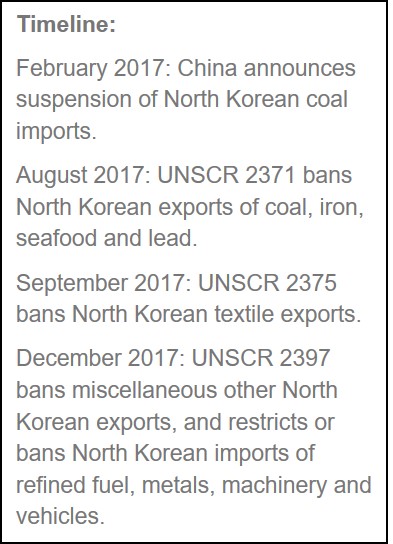 Chinese monthly trade data shows a gradual drop in North Korean exports throughout 2017, with the exception of a spike in August that year in advance of UNSCR 2371’s ban on importing North Korean coal. North Korean exports to China bottomed out with UNSCR 2397 coming into effect in early 2018, and have remained marginal since then. Reported Chinese exports to North Korea in 2018 declined by about 30 percent compared to the previous year (going from about $3.6 billion to $2.5 billion, if one takes estimates of Chinese crude oil exports into account), but climbed back to about $2.9 billion in 2019.[2]
Chinese monthly trade data shows a gradual drop in North Korean exports throughout 2017, with the exception of a spike in August that year in advance of UNSCR 2371’s ban on importing North Korean coal. North Korean exports to China bottomed out with UNSCR 2397 coming into effect in early 2018, and have remained marginal since then. Reported Chinese exports to North Korea in 2018 declined by about 30 percent compared to the previous year (going from about $3.6 billion to $2.5 billion, if one takes estimates of Chinese crude oil exports into account), but climbed back to about $2.9 billion in 2019.[2]
If one digs a little deeper into China’s exports to North Korea, one can see that reported exports of metals, electrical equipment, vehicles and refined petroleum have dropped to near-zero.[3] The few reported Chinese exports included in these sanctioned categories, outside of minor quantities of refined fuel products, appear to be humanitarian goods granted exemptions by the UN’s 1718 Committee. However, exports of goods outside of these categories have modestly increased over the past few years. This implies that Pyongyang has not faced a hard currency crunch serious enough to justify cutting back on lawful imports from China.
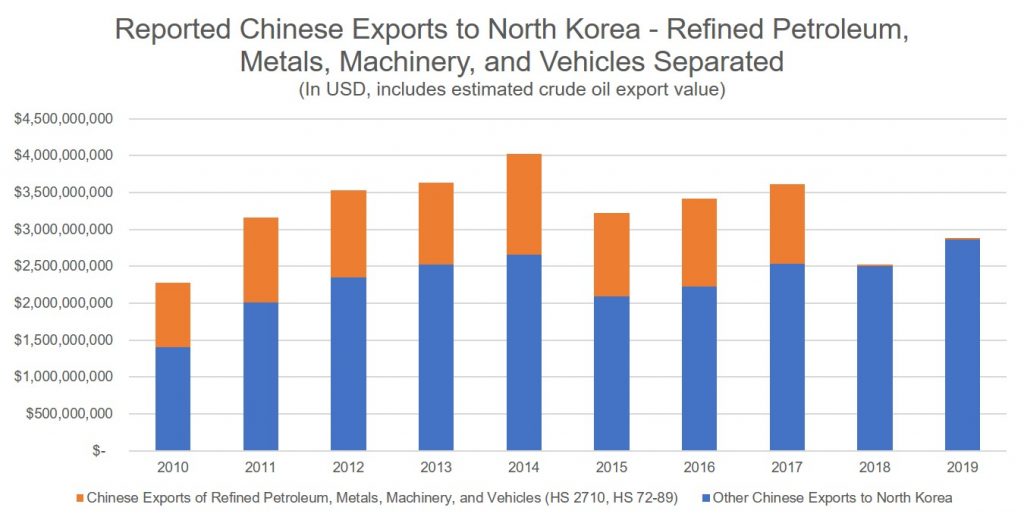
Sanctions Avoidance
Although UN sanctions prohibit most North Korean exports, there is still a narrow range of items that North Korea can legally sell abroad. Beginning in 2017, North Korea began substantially increasing its exports of certain categories of these non-sanctioned goods, such as watches and fake eyelashes, which it had not previously exported in large quantities. Although the total value of these exports remains low, this development demonstrates one way in which North Korea and its Chinese trading partners have adapted to sanctions, and that even if illicit trade is common, there remains something of an incentive for these parties to do business above board when possible.
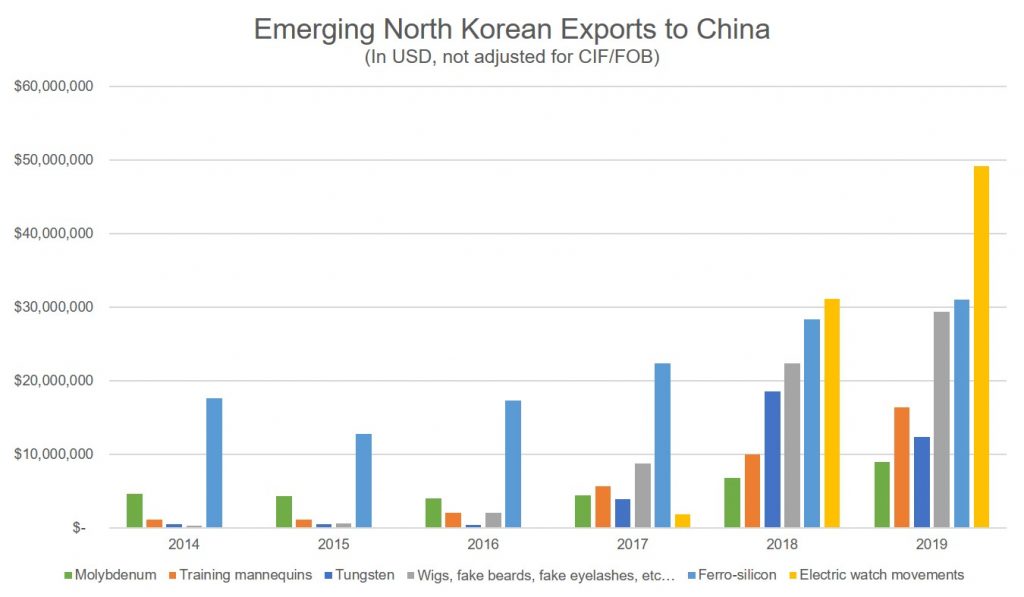
Watches have been North Korea’s most valuable lawful export to China for the past two years: Nearly $50 million in DPRK-made watch movements crossed the border into China in 2019. These watches appear to be produced through an export-processing arrangement with Chinese counterparts, which sent $70 million in watch parts to North Korea last year. (The gap between import value and export value might represent a bottleneck in production, or perhaps simply some unreported North Korean exports.) One would imagine that assembly of the value-added products from North Korea is completed in China, and that at least some of the finished goods might then be reexported with a “Made in China” label. Chinese trade data indicates that this processing trade only began in July 2017, right as sanctions began to constrain North Korean exports.
North Korea has also increased its production of wigs and fake eyelashes in response to UN sanctions. These products have evidently even entered the US market: In January 2019, the US Department of the Treasury’s Office of Foreign Assets Control issued a million-dollar penalty against California-based ELF Cosmetics for inadvertently importing DPRK-made fake eyelashes from a Chinese supplier.[4] More troubling, defectors from North Korea have reported that they produced wigs and fake eyelashes for probable export to China while imprisoned in kyohwaso reeducation camps. However, the post-sanctions climb in North Korean exports of these items occurred subsequent to this reporting, and so it is difficult to say with confidence whether the increased production might also be tied to forced labor.
Additionally, North Korea has increased its exports of several minerals that are not sanctioned by the UN, including ferrosilicon, molybdenum and tungsten. Coal smuggling appears to remain a far more important source of revenue for North Korea than these licit mineral sales, but the increases provide further evidence that the DPRK has at least some incentive to export sanctions-compliant goods to China.
There is also a surprising omission from China’s reported imports from North Korea. Footwear and headgear are arguably outside the scope of UNSCR 2375’s ban on North Korean textile exports, and are goods that North Korea could plausibly produce with a comparative advantage.[5] However, even though China has continued to import these goods from North Korea, it appears to have only been in minor quantities.
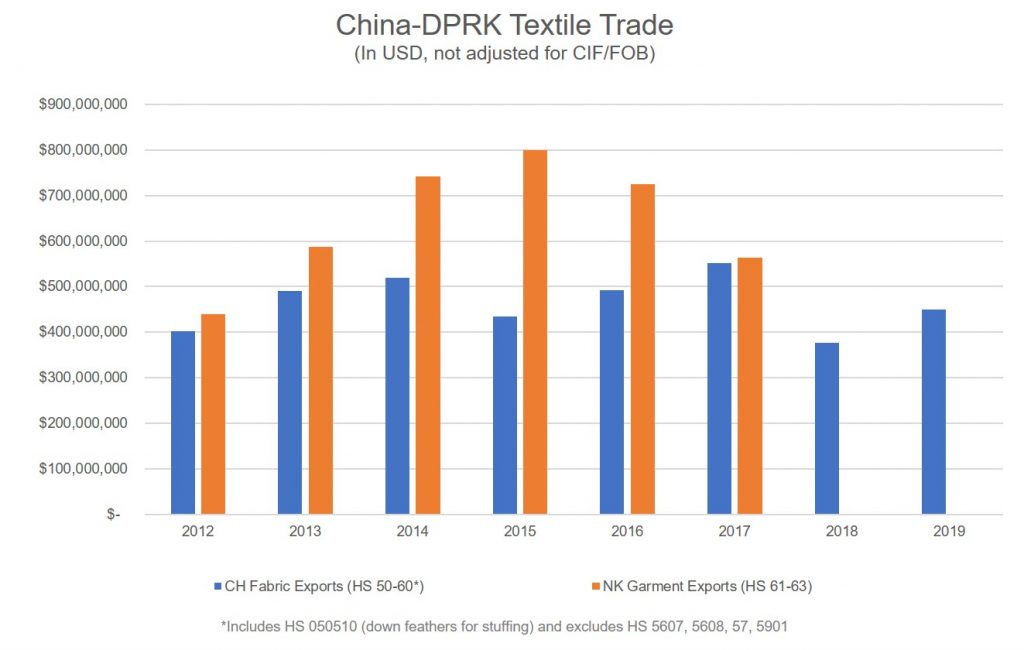
Trade in Textiles
The most plausible reason that a shift from garment to shoe production hasn’t happened is simple: North Korea could be continuing to covertly export textiles abroad in large volumes. Indeed, there is inferential evidence that North Korea’s textile trade with China has mostly continued despite UNSCR 2375’s ban.
The pattern of Chinese trade in textiles with North Korea over the past decade can be characterized as a basic value-added model. Chinese firms send fabrics to North Korea, workers at North Korean textile factories cut and sew these fabrics into garments, and the garments are exported back to China for sale or reexport. If North Korea were no longer exporting garments, then its purchases of imported Chinese fabrics would drop considerably, other than to meet the demands of its domestic market (not everyone wants to wear vinalon all the time, after all). And indeed, Chinese fabric exports to North Korea declined by nearly a third between 2017 and 2018—not as big a decline as one might expect with a robustly-enforced sanctions regime, but significant nonetheless. However, Chinese fabric exports to the North began to increase again last year, implying that unreported North Korean garment exports may be on the rebound.
If, as the data suggests, North Korea is having success with smuggling garments beyond its borders, then the cost and risk of such smuggling would have to be very low. The garment business is well known for having small profit margins, and thus for gravitating toward countries with cheap labor. A high-risk premium would put North Korea at a major competitive disadvantage in this industry. North Korea might be willing to pay above market price for smuggled fuel, or to sell its smuggled coal at a discount rate, simply because it has no other choice. However, a garment wholesaler would have little reason to pay a higher price for North Korean products when they could easily turn to alternative suppliers in Vietnam, Bangladesh or within China.
Trends in Chinese Provincial Trade with North Korea
Historically, Chinese merchandise trade with North Korea has been heavily concentrated in the border provinces of Liaoning and Jilin, which in 2016 accounted for about 60 percent of total reported bilateral trade. Coastal provinces in eastern China have accounted for most of the remainder of bilateral trade with North Korea, while North Korean trade with southern China and provinces in the Chinese interior has been far smaller.
Chinese customs data from the past three years shows a noteworthy shift in these trends. At the start of 2017, exports from landlocked Jiangxi Province in southeastern China to North Korea began to spike, then suddenly declined at the end of the year. Concurrent with this decline, exports from Guangdong Province began to rapidly climb, and this rise has been sustained with the onset of the enhanced UN sanctions regime. For the past two years, reported bilateral trade between Guangdong and North Korea, once a relatively small factor in the Sino-DPRK economic relationship, has been higher than bilateral trade from any other Chinese province.
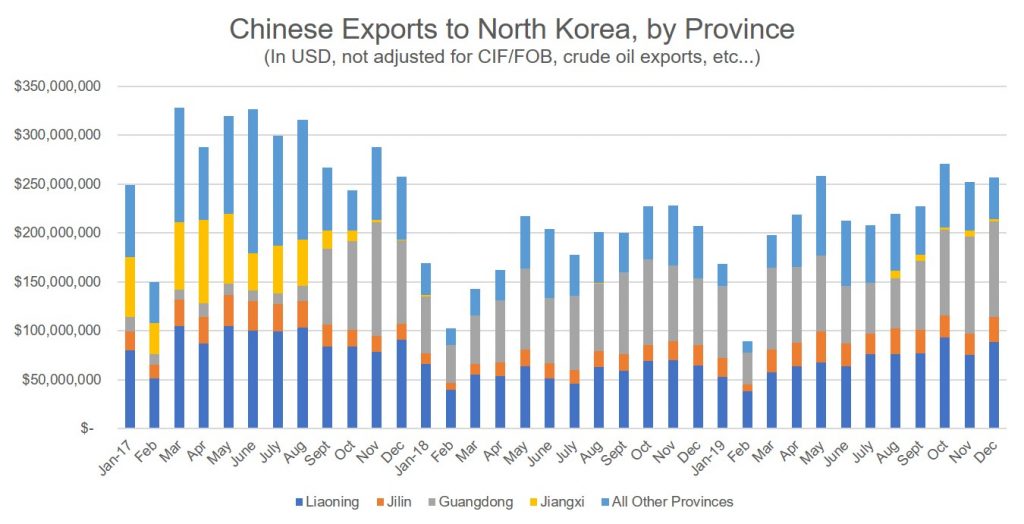
It is unclear why this apparent shift has occurred. The overall profile of Chinese exports to North Korea hasn’t significantly changed, other than the disappearance of sanctioned goods from customs data. Guangdong Province is also reported to export to North Korea significant quantities of goods that likely have their provenance in northern China, such as soybean oil and apples.
Chinese Food Exports
Reported Chinese food exports to North Korea have increased over the three years of enhanced UN sanctions, which helps to explain the relatively low food prices observed in North Korea despite reports of a poor fall 2018 harvest and a decline in production of early-season crops in 2019. Sustained levels of Chinese exports of meats, seafood, fruits and vegetables indicate that sanctions have not scaled back North Korean demand for these relative luxuries.
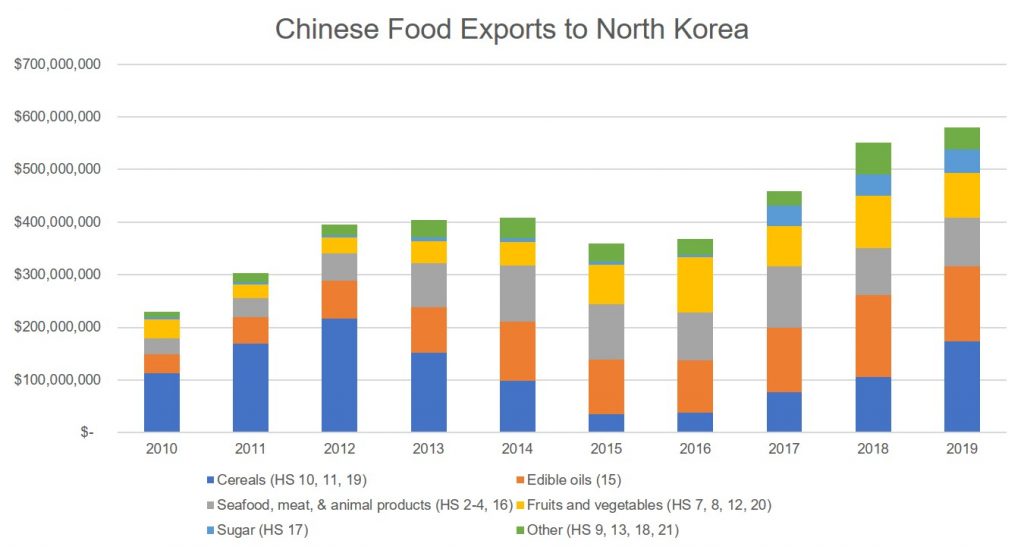
Chinese trade data appears to capture international food aid to North Korea as well as commercial exports, but it is unclear whether these figures also include aid from the Chinese government.[6] After Chinese leader Xi Jinping’s June 2019 visit to Pyongyang, there were rumors that Beijing would provide North Korea with up to a million metric tons of rice and corn aid, but China’s total reported grain exports to North Korea in 2019 only amounted to about 400,000 metric tons. This is a quantity well above the recent average, but it is still far short of the level the Food and Agriculture Organization of the UN estimates would be necessary to meet the total cereal import requirements of the North Korean population.
Additional Observations
A few other trends in recent Chinese trade data with North Korea stand out. First, under China’s rubric of customs categories, nearly no Chinese imports from North Korea over the past two years have been classified as “ordinary trade.” Instead, North Korean imports are listed under various export processing or customs warehousing categories, or as “border trade.” Trade listed under these categories was routine even before the onset of the enhanced UN sanctions regime, but “ordinary trade” had previously been the most common classification. (The overall categorization of Chinese exports to North Korea has not changed as significantly as its imports.)
Second, it is apparent that Chinese Customs has continued to allow the export to North Korea of goods that contain metal or electronics, which are classified outside of the range of goods specifically circumscribed by UNSCR 2397. Anecdotal reports had suggested that (at least for Western travelers to China) Chinese Customs officers had sometimes interpreted UNSCR 2397’s metal export ban to prohibit any metal object from being exported to North Korea, not just those specified in the resolution.[7] However, based on Chinese customs data, metal objects other than those that are specifically banned are still being exported to North Korea through formal channels. This is a welcome finding, as certain categories of humanitarian goods (such as medical appliances) contain metal or electrical components but are not included in the ban.
Conclusions
Recent Chinese trade data presents a few mysteries, but it generally points to the same conclusions that North Korean price data, reports of wide-scale smuggling and sanctions evasion, and anecdotal observations within the country all indicate. North Korea’s economy appears to be staying above water despite sanctions, even though the scope of its foreign trade is constrained and prospects for sustained growth are slim.
The ongoing COVID-19 epidemic has recently led to the effective closure of North Korea’s border with China and could result in a prolonged drop in trade and in North Korean earnings from Chinese tourism. Even if Pyongyang manages to prevent a major outbreak within its territory, the near-term economic impact of the epidemic might prove far greater than that of an enervated sanctions regime. The next few months may provide a grim natural experiment showing what might happen to the North Korean economy if its economic linkages with China truly begin to be severed.
- [1]
William Brown estimates that China supplies North Korea with 500,000 to 600,000 tons of crude oil annually; other sources put it at 520,000 tons. UN Security Council Resolution caps crude oil exports to North Korea at 525,000 tons or 4 million barrels per year, tacitly allowing China’s crude oil exports to North Korea to remain steady while prohibiting other crude oil exports.
- [2]
Note that in the monthly figures there are significant seasonal drops in Chinese exports to North Korea every February—a trend that predates the enhanced sanction regime.
- [3]
Metals, electrical equipment and vehicle exports to North Korea are banned under UNSCR 2397 and defined as all items included under trade codes HS72 – HS89; refined petroleum exports to North Korea are severely restricted under the same resolution.
- [4]
These imports were a violation of the US Department of the Treasury’s North Korea Sanctions Regulations, but not UN sanctions.
- [5]
UNSCR 2375’s ban does not define “textiles” with reference to specific trade codes, but international trade standards put footwear and headgear (HS64 – HS67) in a separate category from textiles (HS50 – HS63).
- [6]
Chinese trade data clearly includes humanitarian exports that have received sanctions exemptions from the UN (goods classified as HS72 – HS89), and, therefore, would likely capture humanitarian exports of food as well.
- [7]
Items classified under trade codes HS72-89.

